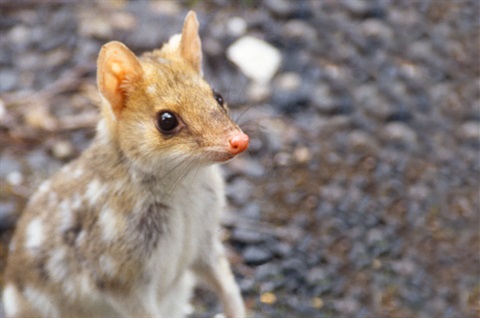Threatened species

Some of Australia's most vulnerable native animals find sanctuary in Hobart's bushland reserves.
We must make sure our reserves remain ecologically healthy and robust. This is critical to protecting these threatened species.
Within the City are 28 vegetation communities which are listed as critically endangered:
- Four vegetation communities are considered to be threatened and listed on Schedule 3A ofTasmania's Nature Conservation Act 2002.
- Ten flora species listed under the Environment Protection and Biodiversity Conservation Act 1999 are known to occur within Hobart's bushland reserves. They are also listed on Tasmania's Threatened Species Protection Act 1995.
- Eleven fauna species listed under the Environment Protection and Biodiversity Conservation Act 1999 are known to occur in our bushlands. Of these, nine are also listed on the state Threatened Species Protection Act 1995.
Of these threatened species, five are endemic to Hobart, including:
- ammonite snail
- forest fingers orchid
- Knocklofty leek-orchid
- Mt Wellington eyebright
- silky snail.
Hobart's threatened wildlife
Eastern quoll
Eastern quolls were once widespread throughout south-eastern Australia. They are now considered extinct on the mainland. They have also recently undergone rapid and severe population decline in Tasmania.
Their distribution is associated with areas of low rainfall and cold winter minimum temperatures. This suggests that climatic changes may be having an impact. Direct competition with feral cats for food has been devastating to the species.
Masked owl
This species is the largest of Tasmania's nocturnal birds. It is an amazing predator and capable of pinpointing small mammals, rats and mice in the dark. It flies just inches above its prey without being detected.
These owls are dependent on large, old-growth hollow-bearing trees that are irreplaceable. In an urban landscape, secondary poisoning from rodent bait is one of the greatest threats to the masked owl.
Its population has been estimated to be only 500 breeding pairs in Tasmania.
Swift parrot
The nationally-listed, critically endangered swift parrot is a small, very fast bird. It winters on the mainland but returns to Tasmania every summer to breed.
It is dependent on blue gum and black gum dominated forest and woodland with large hollow bearing trees. It can be found foraging in Knocklofty Reserve, Ridgeway and Bicenntenial parks.
Eastern barred bandicoot
The eastern barred bandicoot is one of Australia's most endangered species. It is considered extinct in the wild on the mainland and has been almost entirely lost from its original range in Tasmania.
The Queens Domain, Knocklofty and Waterworks reserves are particular strongholds. These provide suitable grassland and grassy woodland habitat.
Predation from cats and dogs is their greatest risk if they are to continue to survive in Hobart's bushland reserves.
Grey goshawk
This large, pure white raptor nests in mature wet forest. It can also be seen in more open woodland and on urban fringes.
There are thought to be less than 110 breeding pairs in Tasmania.